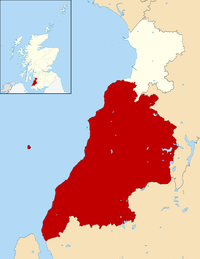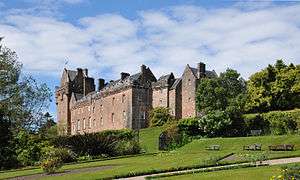Ailsa Craig
Ailsa Craig (/ˈeɪlsə/; Scottish Gaelic: Creag Ealasaid) is an island of 99 hectares (240 acres) in the outer Firth of Clyde, 16 kilometres (10 miles) west of mainland Scotland, upon which blue hone granite has long been quarried to make curling stones. The now uninhabited island is formed from the volcanic plug of an extinct volcano.
| Gaelic name | Creag Ealasaid |
|---|---|
| Meaning of name | Elizabeth's rock or Fairy rock |
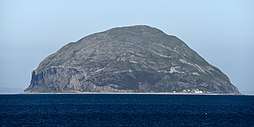 Ailsa Craig from the southeast | |
| Location | |
 Ailsa Craig Ailsa Craig shown within South Ayrshire | |
| OS grid reference | NX019997 |
| Coordinates | 55.25°N 5.11°W |
| Physical geography | |
| Island group | Firth of Clyde |
| Area | 99 hectares (240 acres)[1] |
| Area rank | 150=[1] [2] |
| Highest elevation | 338 m (1,109 ft) (a Marilyn) |
| Administration | |
| Sovereign state | United Kingdom |
| Country | Scotland |
| Council area | South Ayrshire |
| Demographics | |
| Population | 0[3] |
| References | [1][4][5] |
The island, colloquially known as "Paddy's milestone",[6] was a haven for Catholics during the Scottish Reformation in the 16th century, but is today a bird sanctuary, providing a home for huge numbers of gannets and an increasing number of puffins.
Etymology
An early reference to the rock is made by Sir Donald Monro, Archdeacon of the Isles who referred to the rock as "Elsay" in the 16th century.[7] The modern name of the island is an anglicisation of the Gaelic, Aillse Creag meaning "fairy rock".[1] An alternative Gaelic name is Creag Ealasaid meaning "Elizabeth's rock".[1][5] The first element, Aillse may represent Allt Shasann, "cliff of the English", mentioned in the Book of Leinster as Aldasain.[8][9]
The island is sometimes known as "Paddy's Milestone",[5][10] being approximately the halfway point of the sea journey from Belfast to Glasgow, a traditional route of emigration for many Irish labourers going to Scotland to seek work.
As a result of being the most conspicuous landmark in the channel between Ireland and Scotland, the island is known by a number of different names;
- A' Chreag: "the rock"[5]
- Creag Alasdair: "Alasdair's rock"[1]
- Ealasaid a' Chuain: "Elizabeth of the ocean"[5]
- Alasan[5]
- Carraig Alasdair: "Alasdair's Rock" (used in the Madness of Sweeney, the tale of a legendary king of Ireland).[1]
The Bass Rock is sometimes nicknamed "the Ailsa Craig of the East",[11] although its prominence in the Firth of Forth is not as great as that of Ailsa Craig in the Firth of Clyde.
Placenames
A number of features and places on the island have acquired names, Gaelic in most cases, such as Craigna'an (cliff of birds); Trammins (place of Elder trees); Balvar (big round cliff); Garryloo (rough hill) and Ashydoo (black hill).[12] Some names seem self-explanatory and indeed even the 'Swine Cave' may refer to a time when the Earl of Cassilis received part of his rent in hogs from the island.[13]
Geography and geology
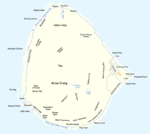
The island is approximately 16 km (10 mi) west of Girvan; it is 4 km (2.5 mi)[14] in circumference and rises to a height of 340 m (1,120 ft).[4] The island is part of the administrative district of South Ayrshire, in the ancient parish of Dailly.
Geologically, Ailsa Craig is the remains of a volcanic plug from an extinct volcano. It stands out because all younger sedimentary rocks covering Southwest Scotland have long since been eroded away (it intrudes Triassic sedimentary rocks now). But the island survived erosion because it is composed of much harder igneous rocks from the Palaeogene period. The plug, which is composed of granite (microgranite of ca. 60 Ma age),[15] is all that remains from the massive volcanic activity caused by the formation of the Atlantic Ocean. Dykes of similar age can be found in Scotland through other older rocks such as the extensive Cleveland and Eskdalemuir dykes. Though only a few metres across, these volcanic dykes can be traced all the way from northern England back to an ancient supervolcano on the Isle of Mull.[16]
Research has shown that the granite on Ailsa Craig has an unusual crystalline composition that has a distinctive appearance but a uniform hardness. These properties have made the island's rock a favourite material for curling stones.[17]
Facilities and ownership
The island has a fresh-water spring but no electricity, gas, sewage or telephone connections.[18] Apart from 2 hectares (4.9 acres) sold to the Northern Lighthouse Board in 1883,[19] the island currently belongs to The 9th Marquess of Ailsa.[6] In May 2011 it was announced that the island was for sale; originally given an asking price of £2,500,000, as of March 2013, the current asking price was for offers over £1,500,000.[6][20][21] Reports in December 2013 claimed an unnamed environmental trust had placed a formal bid,[22] while in April 2014 the National Trust for Scotland was reported to be considering a bid.[23]
The chief well on the island lies above 'the Loups' and this was used by the Northern Lighthouse Board who built a cistern there and piped the water to the lighthouse complex. The 'Horse Well' was located behind the gasworks; the 'Castle Well' stands above Ailsa Castle and then finally the Garry Loch sits higher up and once supplied water to the tenant's cottage.[24]
Four cottages, a shed and a small area of adjacent land are in the ownership of the Scottish Indian business tycoon Bobby Sandhu, purchased for £85,000 from the Northern Lighthouse Board. A five-star hotel was to be built; however, planning regulations prevented this development.[25]
The only surviving buildings on the island are the lighthouse on its east coast facing the Scottish mainland, a ruined towerhouse, that was built by Clan Hamilton to protect the area from Philip II of Spain in the 16th century[18] and the old quarry manager's house that is used by the RSPB.
Mrs Margaret Girvan ran a tearoom[26] in a wooden building that stood next to the tacksman's cottage,[27] famed for its pristine white table cloths and fresh scones. Mrs Girvan kept goats in stone-built goat rees or pens on the good grazing near Garry Loch. The feral billy goats were wont to interfere with these nanny goats and this was another reason for their demise.[26]
Fishermen seem to have used the island for centuries, first being noted in 1549[28] and it is recorded that they even at one time slept beneath sails stretched over hollows on the beach.[29]
A fishermen's cottages row was under construction in the 1840s. However, the main developer died, and the project was abandoned, with the area used instead as a walled kitchen garden until the gasworks was built.[30]
The island seems to have been a part of the Barony of Knockgarron that lay in the Parish of Dailly and the then holder, Duncan of Turnberry, Earl of Carrick established the abbey of Crossraguel and endowed it with the island of Ailsa Craig to "provide for their table".[31] The barony passed through several hands until it became the property of the third Earl of Cassilis in 1548.[19]
History
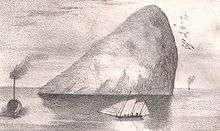
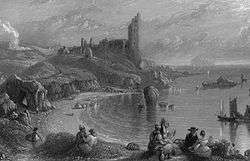
In 1590 the shipping of the Clyde was disrupted by pirates who were said to be Highlanders, quha lyis about Ailsay.[32]
In 1831, The 12th Earl of Cassilis became first Marquess of Ailsa, taking the title from the Craig, which was his property.
An annual hunt of the solan geese or gannets took place in the days of Robert Burns as the flesh was considered a delicacy.[33] Robert Burns's maternal uncle, Samuel Burns was involved in the solan goose trade.[33]
Ailsa Castle
The 12-metre (39 ft) high ruins of a 3-storey castle that stands on the eastern side of the island was built in the late 1500s by the Hamilton Family to protect the island from King Philip II of Spain.[18][34] The island was used as a prison during the 18th and 19th centuries. The castle has two vaulted storeys and an oven is located in a cellar with evidence of a spiral stairway that once ran to the top of the tower. Three cinquefoils arranged in a 'V' shape are carved on the tower and indicate that the Hamiltons were linked with the structure. There are indications of an adjoining building that ran to the north.[35]
Spanish invasion
Ailsa Craig was a haven for Roman Catholics during the Scottish Reformation. In about 1587 the prominent Catholic, Lord Maxwell, landed on Ailsa while attempting to escape his pursuers and finding a fishing boat he attempted to reach Crossraguel Abbey but was captured.[36] In 1597 another Catholic supporter, Hugh Barclay of Ladyland, took possession of Ailsa Craig which he was intent on using as a place of safety for Catholics to practise their faith, for provisioning and stopping off point for a Spanish invasion which would re-establish the Catholic faith in Scotland and a storehouse for provisioning the Catholic Earl of Tyrone in Ireland.[37]
Hugh was however discovered by The Rev. Andrew Knox, a Protestant minister (who later became both Lord Bishop of the Isles and Lord Bishop of Raphoe). Barclay thereafter deliberately drowned himself in the sea[38] or did so accidentally whilst trying to escape.[39] Another version states that Andrew Knox lay in wait for Hugh with nineteen others and ambushed him at the shingle beach with the result that he attempted to defend himself until he was forced back into the sea and drowned.[40]
Smuggling
Beneath the Main Craig at the southern end of the island and 40 ft (12m) above sea level is a cave named after the supposed smuggler MacNall. When the cave was being cleared of guano many years ago two stone coffins were found, both containing human bones. The Rev. Roderick Lawson (1831–1907) thought that one of the interments might be MacNall himself, but no details of this individual have yet come to light. Ailsa Craig would have been an ideal place for the temporary hiding of contraband goods.[41]
Chapels
The island had two chapels and Thomas Pennant who visited Ailsa Craig in 1772 recorded that the ruins of a small chapel were located near the landing place[42] and that another chapel (which he did not visit) was located on the summit of the island and was probably used by seamen to pray for safe voyages and returns.[43] Lawson sees this second chapel as being a myth.[44] When the lighthouse was being constructed four stone coffins were found that may well have been associated with the first mentioned chapel, two at the tenant's house and two at the gasholder site.[45] The monks of Crossraguel Abbey once held the island and "places of prayer" are therefore to be expected especially with a garrisoned castle nearby; it is to be noted that even the diminutive Lady Isle off Troon once had a chapel. The chapel was first mentioned, along with the castle, in 1580 by Sir James Balfour.[46]
Lighthouse, foghorns and gas works
The Lighthouse was built between 1883 and 1886 by Thomas Stevenson; it is owned by the Northern Lighthouse Board.[18]
The lighthouse was automated in 1990 and converted to solar electric power in 2001; the island has been uninhabited since automation in 1990.[18][47] Ailsa Craig and its lighthouse feature extensively in Peter Hill's book Stargazing: Memoirs of a Young Lighthouse Keeper.
Two substantial foghorns with concrete housings were built in 1866, one at the north end of the island near the Swine Cave reached by 'the Loups' path[48] and the other at East Trammins on the south end. Both were powered by compressed air that was piped from the lighthouse, where a gas-powered compressor was housed until 1911 when oil-powered engines were installed.[49] One of the compressed air pipelines can still be seen within 'the Loups' path that was constructed above it. The compressed air cylinders that held the required store of air are still prominent features, especially at the Trammins foghorn. Both foghorns were decommissioned in 1966 and a Tyfon fog signal was used until 1987 when improvements in ship navigation made it also redundant.[49]
The gasworks are still a prominent feature on the island and the cable-powered tramway was partly built to haul wagons full of coal up to it from the North Port. Two gasholders held the coal gas that powered both the compressed air pump and the lighthouse light, however in 1911 the light was converted to incandescent lighting which was powered by electricity.[50][51] The gas works became redundant at this time. Lawson records that oil was used to produce the gas for the lighthouse light.[52]
Railways
Ailsa Craig had two quite separate rail transport systems, one dated from 1886 and supplied coal, oil fuel and provisions to the lighthouse and gas works via the North Port and later the New Jetty and the other transported road stone from the quarries at Kennedy's Nags via the stone crusher to the Quarry Pier. The Northern Lighthouse Board's tramway had a section worked via a powered cableway that hauled wagons up from the North Port and later from the new jetty.
This well-built tram line is largely intact and has a gauge of three feet with junction/points at the gas works and a further set of points that led to a siding that ran down parallel to the gable end of the gas works to presumably collect the coal ash for disposal. The main line runs on down to the lighthouse and its ancillary buildings, taking a right-angled bend to run parallel to the southern end of the lighthouse buildings block.[53] This section of the line was worked by hand and at least two wagons remain at the site together with a set of spare wheels at the gas works.
The mineral line was built by the Ailsa Craig Granite Company Ltd. in 1909 and ran from the quarry at Kennedy's Nags via the stone crusher near the south foghorn to the Quarry Pier.[54] This crudely constructed narrow gauge line was mainly horse drawn, although wagons were also moved by hand or hauled up inclines by winding engines. The mineral railway at the quarry end had a least one siding and a mobile steam crane loaded the larger granite blocks into the wagons that were transported to the stone crusher at the Trammins near the south foghorn, smaller stones being loaded and even moved by hand.[54]
Wagons or bogies were winched up to the substantial stone crusher and gravity was used to deliver the different grades of road stone to the waggons below that were then hauled by horses to the Quarry Pier via a line that ran in front of the lighthouse buildings and took a tight right-angled bend to run up the substantial stone-built incline to the storage area in preparation for delivery via sea to the mainland.[55] Curb stones and stone railway sleepers for sections of the Scotch gauge horse-drawn railway from Ardrossan to Doura were also produced.
Photographs taken in the late 19th century show the horse-drawn wagons passing in front of the lighthouse and portray the substantial railway incline and storage area. At times the production outstripped the storage capacity and a photograph shows at least three piles of different grades of road stone stockpiled in front of the lighthouse enclosure. The track at the crusher had a siding that ran to the crusher and a set of points that led to the Quarry Pier main line.[56]
The Ailsa Craig Granite Company was never a financially sound business and effectively closed in 1928.[54] The course of the mineral line is still evident near the quarries as a linear embankment that ends below Kennedy's Nag. Various artefacts of the quarry enterprise remain, including concrete blocks at Kennedy's Nag and steel and concrete remnants of the stone crusher near the south foghorn.
Curling stones
From the mid-nineteenth century the island has been quarried for its rare type of micro-granite with riebeckite (known as "Ailsite"), which is used to make stones for the sport of curling. As of 2004, 60–70% of all curling stones in use were made from granite from the island[57] and it is one of only two sources for all stones in the sport, the other being the Trefor Granite Quarry in Wales.[58]
Ailsa Craig produced two types of granite for curling, Blue Hone and Ailsa Craig Common Green. Blue Hone has very low water absorption, which prevents the action of repeatedly freezing water from eroding the stone.[59] Ailsa Craig Common Green is a lesser quality granite than Blue Hone. In the past, most curling stones were made from Blue Hone but the quarry is restricted by environmental conditions that exclude blasting.
Kays of Scotland has been making curling stones since 1851 and has the exclusive rights to the Ailsa Craig granite, granted by the Marquess of Ailsa. The last "harvest" of Ailsa Craig granite by Kays took place in 2013, after a hiatus of 11 years; 2,000 tonnes were harvested, sufficient to fill anticipated orders until at least 2020.[60]
Natural history
Sea eagles or erne nested at the Bare Stack until 1881 when the tenant shot the last specimen, which is preserved at Culzean Castle.[61]
Pennant and others have noted that the only trees growing on the island are elders (Sambucus nigra) or bourtrees in the Scots dialect, found as a grove known as The Bourtrees at the Trammins on the southern end of the island.[62] This visitor also rather quaintly mentions that he was surprised to find three species of "reptiles" by which he meant molluscs, namely a naked black slug, the garden snail Cornu aspersum and one of the common striped snails of the genus Cepaea. He speculated that they had accidentally been brought over from the mainland secreted within vegetables.[63]
Slowworms (Anguis fragilis) are found on the island, although they suffered greatly when badgers and racoons were introduced by Lord Ailsa. The badgers did not survive long, but the racoons bred for a number of years.[64]

The mammals fauna included rabbits, and at one time goats, whilst pigs were bred here as food for the inhabitants. The billy goats were shot for sport in the 19th century and no longer survive; only a mounted head of one remains at the McKechnie Institute in Girvan.[65] The rabbits and goats may have been originally introduced to supply food for the fishermen and were mentioned by Pennant in 1772[26] and by the Rev Abercummie in 1688, who called them by the old name of coneys.[66]
The island is now a bird sanctuary, leased by the RSPB until 2050.[67] Huge numbers of gannets nest here.
Rats were probably introduced via shipwrecks; supposedly, a coal boat that sank offshore was the first culprit[68] and caused great harm to the nesting bird populations, with the puffins proving vulnerable to the extent of extinction as breeding birds. After a long campaign using pioneering techniques, the rats were eradicated in 1991, and now puffins are once again raising young on the island with many other benefits occurring to both the fauna and the flora.[69] It is thought that the puffins recolonised Ailsa Craig from Glunimore and Sheep Islands.
In a small glen above Ailsa Castle, a small freshwater body known as the Garry Loch is located at an altitude of 247 metres (810 ft),[70] with a depth of at least 17 feet.[71]
In popular culture
- In chapter 15 of Herman Melville's novel Israel Potter: His Fifty Years of Exile (1855), Ailsa Craig is portrayed as an omen.[72]
- John Keats, during his walk from London to Scotland, composed To Ailsa Rock (as the island was known then) following seeing the island.[73]
Gallery
 The eastern coast photographed from HMS Campbeltown.
The eastern coast photographed from HMS Campbeltown. Columnar rock formations on the south-west side of the island.
Columnar rock formations on the south-west side of the island. Lighthouse seen from the 16th century tower.
Lighthouse seen from the 16th century tower. Summit ridge (338 m) across the Firth of Clyde.
Summit ridge (338 m) across the Firth of Clyde.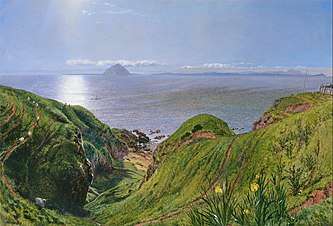 Ailsa Craig by William Bell Scott, oil on canvas (1860)
Ailsa Craig by William Bell Scott, oil on canvas (1860) Ailsa Craig from the west
Ailsa Craig from the west Lighthouse with seals
Lighthouse with seals
Accidents
Lawson in the 1890s records that a young lady once fell over the cliff near Craig Na'an; however, her Victorian style garments caught the wind like a parachute and she escaped with her life and some broken bones that soon knit back together. A visitor in a group from Stranraer was not so lucky and fell to his death on his way down from the summit.
A shocking death was that of a lad from Girvan who was sitting amongst loose rocks, pulling out stones and throwing them into the sea when a very large boulder started to move and crushed him. The stone was too heavy to shift and help from the mainland was required to extract the body of the unfortunate victim. In 1887 a ten-year-old boy died whilst collecting eggs at the West Craigs.[74]
See also
Notes
- Haswell-Smith (2004) p.2
- Area and population ranks: there are c. 300 islands over 20 ha in extent and 93 permanently inhabited islands were listed in the 2011 census.
- National Records of Scotland (15 August 2013). "Appendix 2: Population and households on Scotland's Inhabited Islands" (PDF). Statistical Bulletin: 2011 Census: First Results on Population and Household Estimates for Scotland Release 1C (Part Two) (PDF) (Report). SG/2013/126. Retrieved 14 August 2020.
- Ordnance Survey. OS Maps Online (Map). 1:25,000. Leisure. Retrieved 21 August 2013.
- Mac an Tàilleir (2003) p.3
- BBC News (21 March 2013). "Ailsa Craig: Asking price reduced in Irish Sea island sale". Retrieved 23 May 2013.
- Monro (1549) no. 2
- Clancy (2008) pp. 33–34
- Watson (1926) p.173
- PADDY'S MILESTONE 1947 Film. National Library of Scotland.
- "The Bass Rock". History of Leith. Archived from the original on 5 July 2008. Retrieved 20 October 2009.
- Lawson (1895) p. 9
- Lawson (1895) p. 14
- Haswell-Smith (2004) p.3
- Trewin, Nigel (2002). The Geology of Scotland (4th ed.). Geological Society of London. ISBN 1-86239-126-2.
- "Beyond Plate Tectonics: Plumes, Hotspots, Supervolcanoes and Diamonds" (PDF). Centre for Advanced Study at the Norwegian Academy of Science and Letters. Archived from the original (PDF) on 22 February 2014. Retrieved 14 February 2014.
- Ailsa Craig Archived 11 February 2009 at the Wayback Machine Retrieved 17 October 2007
- "Ailsa Craig" (PDF). Media.primelocation.com. Retrieved 26 August 2012.
- Lawson (1895) p.21
- "UK property for sale". Primelocation.co.uk. Retrieved 1 March 2013.
- "Ailsa Craig island in Firth of Clyde put up for sale". BBC News. Retrieved 1 March 2013.
- McKenna, Kevin (7 December 2013). "Ailsa Craig, granite jewel of the Firth of Clyde, finally finds a buyer". The Guardian. Retrieved 29 August 2016.
- "Trust may buy Aisla Craig with US help". The Herald. 7 April 2014. Retrieved 29 August 2016.
- Lawson (1895) p.62
- Kevin McKenna. "Ailsa Craig, granite jewel of the Firth of Clyde, finally finds a buyer". The Guardian.
- Tait (2005) p.16
- Tait, (2005) p.13
- Lawson (1895) p.11
- Lawson (1895)p.15
- Lawson (1895) p.34
- Lawson (1895) p.20
- Paterson (1863) p. 14
- Purdie p.22
- "Ailsa Craig, Castle. Canmore. Retrieved 15 November 2014.
- Tait (2005) p.37
- Lawson (1895), Page 27
- Lawson (1895), Page 29
- Pennant, Pages 217–218
- Robertson, George (1823). A Genealogical Account of the Principal Families in Ayrshire, more particularly in Cunninghame. Vol.1. Pub. Irvine: Cunninghame press. pp. 72–73.
- Lawson (1895) p. 30
- Taot. p. 66
- Pennant, P. 217
- Pennant, Page 218
- Lawson (1895), Page 16
- Lawson (1895), Page 34
- Lawson (1895) p.12
- Northern Lighthouse Board – Automation of lighthouse Archived 23 February 2010 at the Wayback Machine Retrieved on 28 January 2008
- Tait (2005) p.25
- Tait(2005) p.26
- Tait (2005) p.19
- Tait(2005) p.24
- Lawson (1895) p.76
- Tait (2005) p.14
- Tait (2005) p. 28
- Tait (2005) p.9
- Tait (2005) p.30
- National Geographic Retrieved on 19 July 2009
- "Sochi 2014: 10 things you didn't know about curling". BBC Sport.
- "About Curling/Stones". Anchorage Curling Club. Archived from the original on 15 April 2012. Retrieved 4 August 2012.
- "News". Kays of Scotland. Archived from the original on 26 February 2013. Retrieved 4 August 2012.
- Lawson (1895), Page 42
- Tait (2005) p.27
- Pennant, Page 216
- Lawson (1895), Page 59
- Tait (2005) p.17
- Lawson (1895) p.14
- "RSPB stress importance of Ailsa Craig, but are not in negotiations to purchase iconic landmark". RSPB. Retrieved 14 July 2011.
- Lawson (1895), Page 63
- Tate, Page 76
- Tait (2005) p.38
- Lawson (1895) p.36
- Howard, Leon (1993) Herman Melville: A Biography. University of California Press. p. 238
- http://www.scottishpoetrylibrary.org.uk/poem/ailsa-rock/
- Lawson (1895) p.73
References
- Clancy, Thomas Owen (2008), "The Gall-Ghàidheil and Galloway", Journal of Scottish Name Studies, 2: 19–50, ISSN 1747-7387
- Haswell-Smith, Hamish (2004). The Scottish Islands. Edinburgh: Canongate. ISBN 978-1-84195-454-7.
- Mac an Tàilleir, Iain (2003) Ainmean-àite/Placenames. (pdf) Pàrlamaid na h-Alba. Retrieved 26 August 2012.
- Lawson, Roderick (1888). Ailsa Craig : Its History & Natural History. Paisley : J & R Parlane.
- Lawson, Roderick (1895). Ailsa Craig : Its History & Natural History. Paisley : J & R Parlane.
- Monro, Sir Donald (1549) A Description Of The Western Isles of Scotland. Appin Regiment/Appin Historical Society. Retrieved 3 March 2007. First published in 1774.
- Paterson, James (1863–66). History of the Counties of Ayr and Wigton. V. – I – Kyle. Edinburgh: J. Stillie.
- Pennant, Thomas (1776). Tour in Scotland and Voyage to the Hebrides. Chester : John Monk.
- Purdie, David; McCue Kirsteen and Carruthers, Gerrard. (2013). Maurice Lindsay's The Burns Encyclopaedia. London : Robert Hale. ISBN 978-0-7090-9194-3.
- Tait, Norman T. (2005). Kirk on the Craig. Pub. Friends of the McKechnie Institute.
- Watson, W.J., The Celtic Place-Names of Scotland, (Edinburgh, 1926) reprinted, with an Introduction, full Watson bibliography and corrigenda by Simon Taylor (Edinburgh, 2004)

External links
| Wikivoyage has a travel guide for Ailsa Craig. |
| Wikimedia Commons has media related to Ailsa Craig. |
